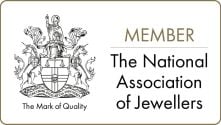60th and 75th Wedding Anniversary Gift
Diamond
The hardest known substance to man. Right at the top of Mohs’ scale of hardness at 10.
There is a greater difference in hardness between Corundum (sapphire and ruby) at 9 on the scale and diamond at 10 than there is between talc at 1 and corundum at 9.
This extreme hardness makes diamond the ultimate choice for jewellery of any type. However, despite its hardness, it is still possible to damage diamonds by knocking them which, in the best case of damage could cause chopping to the girdle (edge) of the gem and, in the worst case it could cause the diamond to split along a cleavage plane (a direction of weakness in the diamond crystal). For this reason we would always recommend that any gem-set rings are removed when doing any hard physical work.
Diamonds display an adamantine lustre when cut and polished. This is the highest lustre possible. If the diamonds in your jewellery start to look dull this is usually easily remedied by cleaning the diamond. Diamonds attract grease and that in turn will attract dust and dirt debris. A wash in warm soapy water and a soft brush is usually all that is needed but if dirt has built up over a length of time it may need to soak for a while first. (Do not leave any porous gems to soak and do not leave any jewellery containing material that may have been glued or cemented in place to soak as it may cause damage.)
We are often asked why two diamonds, which appear to be the same size, have very different prices. The way diamond prices are determined is using the “ 4 C’s”: Colour, cut, clarity and carat weight. Details of these important factors can be found in our dedicated article:
Once you have an understanding of the 4 C’s you can start to make an informed decision about the particular diamond you would like to own. Sometimes you have to make a compromise on either the colour, clarity or size to enable you to keep within your budget and even a small drop on the colour grade or the clarity grade may allow you to retain a larger size diamond, or drop a fraction on the size and you could keep the higher colour and clarity. The cut area of the 4 C’s refers to how well the diamond has been cut in terms of symmetry and whether the stone is too deep or too shallow to allow the light to pass through correctly.
Diamonds tend to be the traditional gemstone of choice for engagement and eternity rings, either alone or with coloured gemstones. They can be mounted in yellow or white gold or platinum – personal choice. Often, even if the ring shank is yellow gold, the diamond is set in white gold or platinum as a yellow setting can make the diamond appear to have a yellow tinge. Bear in mind that if you choose a white gold ring mount it will be rhodium plated to give it a bright white finish and, as with any plating, over time this will wear off and you will need to have it re-rhodium plated, a process which involved stripping off any remaining rhodium, thoroughly cleaning and polishing the mount and then re-plating. For those who wish to avoid this process and being without their jewellery whilst the work is carried out then the best choice would be platinum which is a naturally white metal and therefore does not need any plating.
As far as styles of mount are concerned, whatever the item is, ring, pendant, earrings, the ideal setting for a diamond is one that allows the light to penetrate the gem, and exit from the top of the gem to create the maximum dispersion (projection of the rainbow colours). Claw settings are usually very good for this. However, for many reasons, some people prefer a smooth, rub over style of setting and although they do enclosed the diamond more than a claw setting, some rub over mounts have slits around the edges to allow the light to pass into the diamond. Another smooth style of setting is the channel setting, frequently used for eternity rings where the diamonds are in a straight line and are held either side of the setting in a small channel. This style is often used for round brilliant cut diamonds, square princess cut diamonds or rectangular baguette cut diamonds.



Gerry & Co (Jewellers) Ltd have a superb collection of both new and preloved diamond jewellery to suit all tastes and budgets.
Also available from our stock of diamond jewellery you will find diamond pendants and earrings both of which are seen as classic statement pieces of jewellery and they make ideal gifts for any occasion.


You can purchase your diamond jewellery from Gerry & Co (Jewellers) Ltd with confidence knowing that we deal with reputable suppliers and that we have the experienced staff and fully up to date equipment to enable us to test our diamond stock to make sure that there are no man-made, synthetic diamonds as we only sell natural mined diamonds. The image below shows a natural diamond crystal and if you look carefully you can see a small triangle on the top front face of the crystal and this is a naturally occurring feature called a trigon.

In our video you can see some rough diamond crystals and also a replica of the Cullinan diamond, which was discovered in 1905 and weighed 3,106.75 carats. It took eight months to cut and polish the stone into nine major stones named Cullinan I – IX, 96 splinters and 9 carats of rough ends and caused a total weight loss of 65.25%. The name of the stone came from the owner of the mine in which it was discovered (Thomas Cullinan)
The Cullinan I and II are set in the Crown Jewels, I in the Sovereign’s sceptre and II in the Imperial State Crown. III to IX were kept by Asscher’s of Amsterdam as payment for their work cutting and polishing the stones. Cullinan IV and V were later purchased privately by King Edward VII as a gift for Queen Alexandra and the others went to the South African government who later gave them to Queen Mary in 1910. They were, in turn, passed to Queen Elizabeth II in 1953 and these stones (III, VI, VII, VIII and IX) formed part of her personal jewellery collection.
It is good to be able to view a selection of diamonds to see just how much they vary. Here at Gerry & Co (Jewellers) Ltd, we are always happy to source one for you if we don’t already have a suitable one in stock.
We can make a diamond item to your specifications, however, please be aware that this can be a lengthy process so don’t leave it to the last minute if it is for a special occasion as the gem has to be sourced and often the mount will have to be handmade by our jeweller, a highly skilled craftsman who will work on the item for hours at a time. We are always pleased to be able to obtain a quote for a bespoke item.
Thank you for reading our diamond article. We are putting together more posts on other gemstones. Please have a look at some more:
Ruby – July Birthstone
Emerald – May Birthstone
Pearl – June Birthstone




